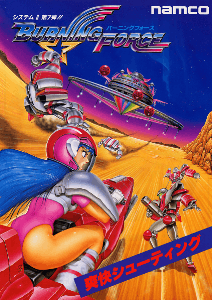Burning Force
| Burning Force | |
|---|---|
|
Arcade flyer | |
| Developer(s) | Namco |
| Publisher(s) | Namco |
| Composer(s) | Yoshinori Kawamoto |
| Platform(s) | Arcade, Sega Genesis, Virtual Console |
| Release date(s) |
Arcade‹See Tfd›
Mega Drive‹See Tfd›
‹See Tfd›
‹See Tfd›
Virtual Console
|
| Genre(s) | 3D shooter |
| Mode(s) | Up to 2 players (alternating turns) |
| Cabinet | Upright, cabaret, and cocktail |
| Arcade system | Namco System 2 |
| CPU |
2x Motorola 68000 @ 12.288 MHz Motorola M6809 @ 3.072 MHz Hitachi HD63705 @ 2.048 MHz |
| Sound |
Yamaha YM2151 C140 |
| Display | Horizontal orientation, raster, 288 x 224 resolution |
Burning Force (バーニングフォース Bāningu Fōsu) is a 3D shooter arcade game which was released by Namco in 1989 only in Japan. It runs on Namco System 2 hardware and was later ported to the Sega Mega Drive in 1990, and was also later released on the Wii Virtual Console in 2009.
Gameplay

In Burning Force, the player controls a 21-year-old space cadet named Hiromi Tengenji (天元時ひろみ Tengenji Hiromi), who as part of her final training, must battle high-tech enemies through six worlds of four areas on a futuristic airbike named "Sign Duck". The gameplay is similar to that of Sega's Space Harrier, but the worlds are divided into four areas and there is no vertical mobility making the game different in its own right; in the first two sections the player controls Hiromi on the airbike, which can move to the left and right, as well as braking and accelerating - and the airbike can also fire bullets and missiles at the enemies. The third area of every world is a boss area and the airbike will be transformed into a flying ship which can move in all directions; the fourth area of each world, however, is a bonus stage and the player has to collect as many spheres (which have numbers on them) as possible for bonus points.[1][2]
Reception
The Sega Genesis / Mega Drive received mixed and mostly mediocre reviews in the West upon the release, including 4/10 from ASM,[3] 5/10 from Génération 4,[4] 71% from Joystick,[5] 51% from Power Play,[6] and 77% from RAZE, which opined "Space Harrier is too old a formula to be successful nowadays."[7] The New Straits Times, in October 1990, dismissed the game as "yet another ... in the line of Space Harrier clones."[8] Retrospectively, Hardcore Gaming 101's Kurt Kalata opined it "is among the better of [Space Harrier] clones, partly because it's based on more powerful arcade hardware (the Namco System-II, which ran Phelios and Valkyrie no Densetsu, amongst others), and partly because it puts its own unique spin on the formula."[1]
Legacy
Hiromi Tengenji went on to reappear in an advertisement on an airship in Mach Breakers (along with Pac-Man, Prince Gil and Princess Ki from The Tower of Druaga, Wonder Momo, Valkyrie from Valkyrie no Densetsu, and Pitto and Patti from Tinkle Pit) and also appeared in the Namco System 12-era World Stadium games as the Nikotama Gals' defensive half. She is one of player's party characters in Namco x Capcom, where she is partners with Toby "Kissy" Masuyo, the main character of the Baraduke games.[1] In ShiftyLook's Namco dating sim Namco High,[9] she appears as one of 18 dateable characters. Namco High writer Ananth Panagariya said: "While we did want to use some big characters (Voldo!), we were happy to discover that because some of these properties had lain dormant for so long, we were essentially free to redefine them." The game's lead designer Conrad Kreyling also said Hiromi was the character he would by far most like to date ("The strong, silent type, her amazing color palette, and that bike!").[10] Namco Game Sound Express Vol. 02 - Burning Force, published by Victor Entertainment in 1990, contains the original soundtrack from Burning Force with compositions by Yoshinori Kawamoto.
References
- 1 2 3 Kalata, Kurt (2013-05-21). "Burning Force". Hardcore Gaming 101. Retrieved 2015-11-07.
- ↑ "バンダイナムコ、「バーニングフォース」を7月14日にバーチャルコンソール アーケードで配信開始 -GAME Watch". Game.watch.impress.co.jp. Retrieved 2015-11-07.
- ↑ "DIE Kult-Seite über die alten Spiele-Magazine und Retro-Games!". Kultboy.com. Retrieved 2015-11-07.
- ↑ "Le site des anciennes revues informatiques". www.abandonware-magazines.org. Retrieved 2015-11-07.
- ↑ "Le site des anciennes revues informatiques". www.abandonware-magazines.org. Retrieved 2015-11-07.
- ↑ "Power.Play.N34.1991.01-kultpower". Archive.org. Retrieved 2015-11-07.
- ↑ "Raze Magazine Issue 03". Archive.org. Retrieved 2015-11-07.
- ↑ "New Releases". New Straits Times. October 25, 1990. Retrieved September 24, 2016.
- ↑ "Namco High". Namcohigh.klonoa.org. Retrieved 2015-11-07.
- ↑ "The Namco High Interview We Never Expected, Because Who Imagined This?". Siliconera. 2013-12-16. Retrieved 2015-11-07.
External links
- Official website (VC)
- Burning Force at the Killer List of Videogames
- Burning Force at MobyGames
- Burning Force at the Arcade History database
